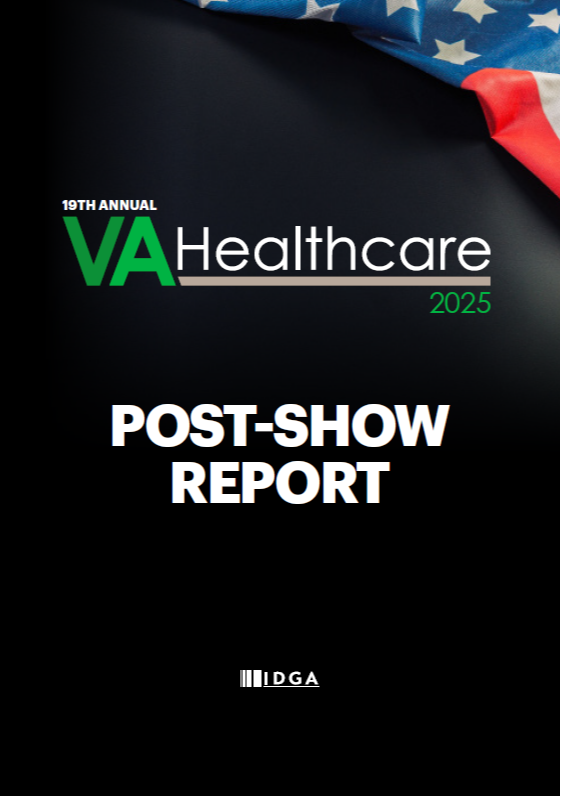Exclusive Content

Veterans Affairs Funding in FY 2026
This March, Congress passed the Full-Year Continuing Appropriations and Extensions Act, 2025, which lays out funding for federal agencies including the Department of Veteran Affairs. As outlined in the bill, Congress is appropriating $420.7 billion to the VA in FY 2026. The funding figures outlined in this infographic become available to the VA on October 1, 2025.
![[Exclusive Presentation] Advocating for Improved Care for Veterans: Insights from American Medical Association [Exclusive Presentation] Advocating for Improved Care for Veterans: Insights from American Medical Association](https://eco-cdn.iqpc.com/eco/images/event_content/ifvDv6J4lhCEtdvc0tBoumHjmQwMy1kJBO51G8Cs.png)
[Exclusive Presentation] Advocating for Improved Care for Veterans: Insights from American Medical Association
As a preview of the caliber of content you can expect by attending the IDGA VA Healthcare Summit, we are thrilled to share an exclusive presentation delivered at the 2024 iteration by Dr. Bruce A. Scott, President of the American Medical Association, on the urgent challenges and critical reforms shaping the future of veteran healthcare.
In this presentation, you’ll learn about:
- Rising health challenges among U.S. veterans — including PTSD, substance use, and mental health struggles.
- Physician burnout and workforce shortages — and how they threaten healthcare sustainability.
- Policy reforms and advocacy efforts — including Medicare payment reform, physician-led care defense, and expanded veteran access to quality services.
- The responsible integration of AI — ensuring human-centered, clinician-guided decision-making in medicine.
By downloading this presentation, you’ll gain valuable insights into the national priorities, legislative efforts, and frontline challenges driving veteran healthcare policy today.

VA Healthcare 2025 Post Show Report
IDGA’s VA Healthcare Summit returned this July for its 19th year. This year’s two-day summit was held at the MGM Grand in National Harbor, Maryland, and was the largest iteration of the event to date with over 650+ attendees representing military, government, private and non-profit healthcare sector, academia and consultant communities.
This year’s agenda proved to be jam-packed with a diverse collection of speakers covering topics that include the integration of a brand-new electronic health record system, new drugs and procedures, access to mental health services, innovative AI/ML solutions, and much more.
Before looking ahead to the 2026 summit, which is set to return to the MGM Grand July 28-29, 2026, IDGA has created this post-show report. Inside this report gain key takeaways from the summit, testimonials from attendees, and a full list of attending organizations.

A Timeline of VA EHR Modernization Efforts and What to Expect in 2025
The Department of Veteran Affairs’ (VA) Veterans Health Administration (VHA) healthcare program provides more than 9 million American veterans healthcare through its 1,255 healthcare facilities. As the largest integrated healthcare network in the U.S., the VHA faces the tall order of managing the health records of millions of veterans.
This report looks at the value Electronic Health Records (EHR) provide the VA and establishes a timeline of the agency's efforts to implement EHR across its healthcare network.
![[Exclusive Presentation] VHA Innovation Ecosystem - Dr. Mark Zhang [Exclusive Presentation] VHA Innovation Ecosystem - Dr. Mark Zhang](https://eco-cdn.iqpc.com/eco/images/event_content/cxI0cUxm7RbCuVK43NmZZMOGkxoK4FpOrBvtWiBu.png)
[Exclusive Presentation] VHA Innovation Ecosystem - Dr. Mark Zhang
Unlock the Future of VA Healthcare
As a preview of the caliber of content you can expect by attending the IDGA VA Healthcare Summit, we are thrilled to share an exclusive presentation delivered at the 2024 iteration by Dr. Mark Zhang, Chief Innovation Officer, Office of Healthcare Innovation and Learning (OHIL), Veterans Health Administration.
What You'll Discover:
- How OHIL is pioneering healthcare innovation, from AI to digital health and medical devices.
- Breakthroughs in rapid prototyping, pilot programs, and cutting-edge technologies improving veteran care.
- Real-world success stories of transformational projects driving VA healthcare forward.
Download the Full Presentation to see what’s next in veteran healthcare innovation!

2025 Attendee Snapshot | VA Healthcare Summit
The VA Healthcare Summit annually brings together over 700 senior leaders, clinicians, nurses, administrators, and technology professionals from across the veterans' healthcare sector, to share ideas and strategies, network and collaborate on delivering the highest-quality care to the nation's veterans.
Take a look at the 2025 attendee list to see who you could meet at this year's VA Healthcare Summit >>

Goals and Objectives of the VA's Prosthetic and Sensory Aid Services
One of the highest priorities in the U.S. is providing the safety and wellbeing of its veterans. Whether that entails curbing veteran homeless, deterring substance abuse, or providing accessible medical care, the Department of Veterans Affairs is at the forefront of these efforts. One avenue through which the VA continually serves veterans is Prosthetic and Sensory Aid Services (PSAS), which provides devices that support or replace a body part or function.
Penny Nechanicky is the Director of PSAS, the largest provider of prosthetics and sensory aids in the world. In her role, Penny’s responsibilities include oversight and direction of Orthotic and Prosthetic Services, Automobile Adaptive Equipment, Home Improvement and Structural Alterations (HISA) Grant, Clothing Allowance and Service Dog/Guide Dog.
During the 2024 VA Healthcare Summit, Penny provided a full overview of the VA’s core competencies in prosthetics and sensory aids. Before the event, Penny spoke with IDGA about the key focus areas and challenges at PSAS.

VA Telehealth Initiatives and Challenges to Know About
When the Covid pandemic began in the U.S. in March 2020, patient care was forced to quickly reimagine itself as hospitals became overcrowded and staff were overstrained. In October 2022 the CDC reported that 37% of U.S. adults use telemedicine, including 43.3% of adults over 65. The Department of Veterans Affairs, which serves over 9 million American veterans has also been proactive in embracing the new era of telehealth. According to the VA, one in three veterans use telehealth capabilities when receiving care from the VA.
With more veterans than ever seeking medical assistance virtually, the VA has had to advance its remote patient care capabilities. In May 2023, the VA announced that four companies have been selected to potentially win an 8-year, $1 billion contract to help the VA roll out systems and supplies for telehealth functions.
This initiative is one of several the VA has committed to in the past decade, and this report will look at what those initiatives are and their effectiveness in providing veterans with virtual care.

VA Healthcare 2024 Post-show Report
Across the United States Government, no priority is more imperative than providing the highest-quality care to our nation’s Veterans, and the Department of Veterans Affairs is responsible for providing healthcare services to over 9 million veterans, making it the largest integrated healthcare network in the US.
IDGA recognizes the VA finds itself at a critical moment having to meet the challenges of the pandemic, shifting demographics, and the winding down of the Global War on Terror. For the past 18 years the VA Healthcare Summit has provided healthcare professionals an opportunity to discuss these changes as well as efforts to deliver telehealth and virtual care, electronic health records systems, and the use of new drugs and surgeries to VA care.
On July 23-24, over 700 attendees including VA clinicians, nurses and administrators as well as senior stakeholders, technology experts, and industry innovators, gathered in Arlington, Virginia to learn, share, and connect with our nation’s veterans to improve health outcomes, care access, and delivery. This report will highlight some of the takeaways from attendees and summarize important discussions held during the conference.



